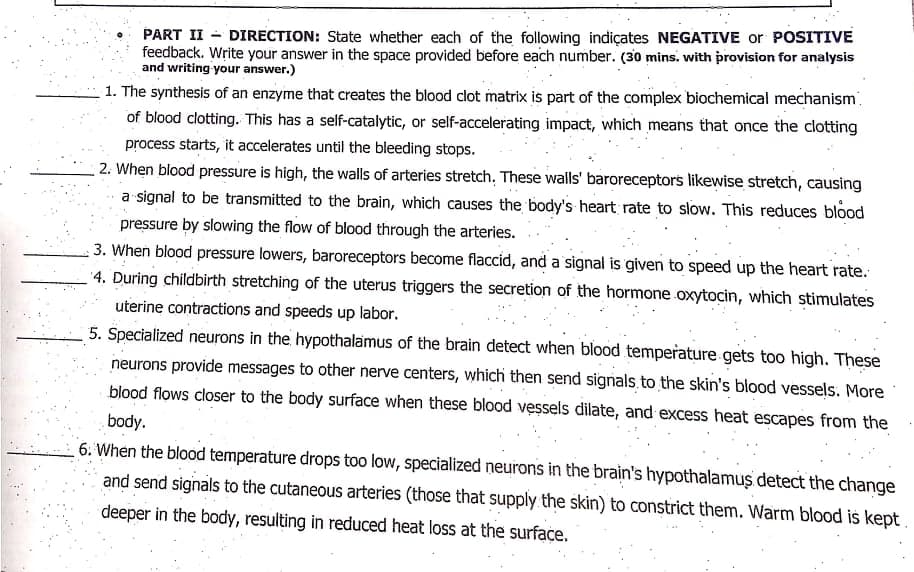PART II - DIRECTION: State whether each of the following indiçates NEGATIVE or POSITIVE feedback. Write your answer in the space provided before each number. (30 mins. with provision for analysis and writing your answer.) 1. The synthesis of an enzyme that creates the blood clot matrix is part of the complex biochemical mechanism. of blood clotting. This has a self-catalytic, or self-accelerating impact, which means that once the clotting process starts, it accelerates until the bleeding stops. 2. When blood pressure is high, the walls of arteries stretch. These walls' baroreceptors likewise stretch, causing a signal to be transmitted to the brain, which causes the body's heart rate to slow. This reduces blood pressure by slowing the flow of blood through the arteries. 3. When blood pressure lowers, baroreceptors become flaccid, and a signal is given to speed up the heart rate. '4. During childbirth stretching of the uterus triggers the secretion of the hormone oxytocin, which stimulates uterine contractions and speeds up labor. 5. Specialized neurons in the hypothalamus of the brain detect when blood temperature gets too high. These neurons provide messages to other nerve centers, which then send signals to the skin's blood vessels. More blood flows closer to the body surface when these blood vessels dilate, and excess heat escapes from the body. 6. When the blood temperature drops too low, specialized neurons in the brain's hypothalamus detect the change and send signals to the cutaneous arteries (those that supply the skin) to constrict them. Warm blood is kept deeper in the body, resulting in reduced heat loss at the surface.
PART II - DIRECTION: State whether each of the following indiçates NEGATIVE or POSITIVE feedback. Write your answer in the space provided before each number. (30 mins. with provision for analysis and writing your answer.) 1. The synthesis of an enzyme that creates the blood clot matrix is part of the complex biochemical mechanism. of blood clotting. This has a self-catalytic, or self-accelerating impact, which means that once the clotting process starts, it accelerates until the bleeding stops. 2. When blood pressure is high, the walls of arteries stretch. These walls' baroreceptors likewise stretch, causing a signal to be transmitted to the brain, which causes the body's heart rate to slow. This reduces blood pressure by slowing the flow of blood through the arteries. 3. When blood pressure lowers, baroreceptors become flaccid, and a signal is given to speed up the heart rate. '4. During childbirth stretching of the uterus triggers the secretion of the hormone oxytocin, which stimulates uterine contractions and speeds up labor. 5. Specialized neurons in the hypothalamus of the brain detect when blood temperature gets too high. These neurons provide messages to other nerve centers, which then send signals to the skin's blood vessels. More blood flows closer to the body surface when these blood vessels dilate, and excess heat escapes from the body. 6. When the blood temperature drops too low, specialized neurons in the brain's hypothalamus detect the change and send signals to the cutaneous arteries (those that supply the skin) to constrict them. Warm blood is kept deeper in the body, resulting in reduced heat loss at the surface.
Chapter8: Forms Of Drugs And How They Act
Section: Chapter Questions
Problem 29RQ
Related questions
Question

Transcribed Image Text:PART II - DIRECTION: State whether each of the following indiçates NEGATIVE or POSITIVE
feedback. Write your answer in the space provided before each number. (30 mins. with provision for analysis
and writing your answer.)
1. The synthesis of an enzyme that creates the blood clot matrix is part of the complex biochemical mechanism.
of blood clotting. This has a self-catalytic, or self-accelerating impact, which means that once the clotting
process starts, it accelerates until the bleeding stops.
2. When blood pressure is high, the walls of arteries stretch. These walls' baroreceptors likewise stretch, causing
a signal to be transmitted to the brain, which causes the body's heart rate to slow. This reduces blood
pressure by slowing the flow of blood through the arteries.
3. When blood pressure lowers, baroreceptors become flaccid, and a signal is given to speed up the heart rate.
'4. During childbirth stretching of the uterus triggers the secretion of the hormone oxytocin, which stimulates
uterine contractions and speeds up labor.
5. Specialized neurons in the hypothalamus of the brain detect when blood temperature gets too high. These
neurons provide messages to other nerve centers, which then send signals to the skin's blood vessels. More
blood flows closer to the body surface when these blood vessels dilate, and excess heat escapes from the
body.
6. When the blood temperature drops too low, specialized neurons in the brain's hypothalamus detect the change
and send signals to the cutaneous arteries (those that supply the skin) to constrict them. Warm blood is kept
deeper in the body, resulting in reduced heat loss at the surface.
Expert Solution
This question has been solved!
Explore an expertly crafted, step-by-step solution for a thorough understanding of key concepts.
This is a popular solution!
Trending now
This is a popular solution!
Step by step
Solved in 2 steps

Knowledge Booster
Learn more about
Need a deep-dive on the concept behind this application? Look no further. Learn more about this topic, biology and related others by exploring similar questions and additional content below.Recommended textbooks for you


Anatomy & Physiology
Biology
ISBN:
9781938168130
Author:
Kelly A. Young, James A. Wise, Peter DeSaix, Dean H. Kruse, Brandon Poe, Eddie Johnson, Jody E. Johnson, Oksana Korol, J. Gordon Betts, Mark Womble
Publisher:
OpenStax College

Human Physiology: From Cells to Systems (MindTap …
Biology
ISBN:
9781285866932
Author:
Lauralee Sherwood
Publisher:
Cengage Learning


Anatomy & Physiology
Biology
ISBN:
9781938168130
Author:
Kelly A. Young, James A. Wise, Peter DeSaix, Dean H. Kruse, Brandon Poe, Eddie Johnson, Jody E. Johnson, Oksana Korol, J. Gordon Betts, Mark Womble
Publisher:
OpenStax College

Human Physiology: From Cells to Systems (MindTap …
Biology
ISBN:
9781285866932
Author:
Lauralee Sherwood
Publisher:
Cengage Learning